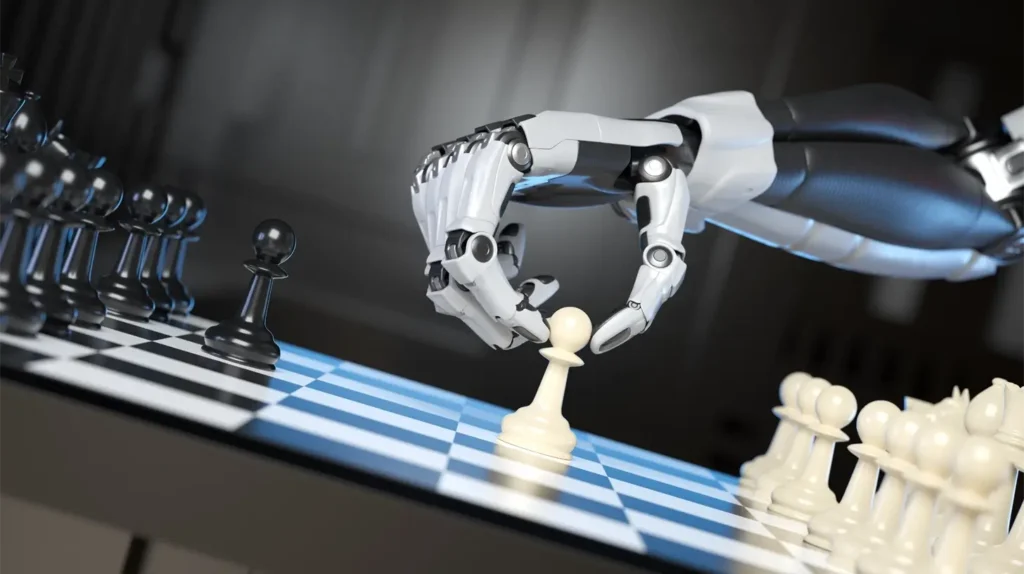Artificial intelligence is disrupting our web content creation habits. What seemed like science fiction a few years ago has become a reality. The spectacular advances of models such as ChatGPT, Claude.ai, Midjourney or DALL-E are just the tip of the iceberg, and 2025 promises to be a pivotal year in this digital revolution.
I see that more and more companies are wondering how to best integrate these tools into their content strategy. The market is beginning to see AI as an opportunity rather than a threat. And for good reason: those who master this technology will have a considerable competitive advantage in the years to come.
In this article, I offer a comprehensive overview of generative AI applied to web content creation. From the latest technological advances to good integration practices, including legal and financial aspects, I will give you all the keys to approach this revolution with serenity.
The generative AI revolution: understanding the fundamentals

According to McKinsey’s latest Global Survey, 72% of organizations worldwide are now using artificial intelligence (AI) in their operations, up from 50% in previous years, while 65% specifically use generative AI regularly across their business functions. For these organizations, the challenge is significant: how can they leverage these powerful technologies while maintaining their authenticity? AI-assisted content creation offers fascinating possibilities but also raises important questions about accuracy and risk management, with 44% of organizations already experiencing some form of negative consequences from generative AI use.
AI tools and their specificities
The year 2025 marks a milestone in the evolution of generative artificial intelligence. The market has been structured around several major players, each with its own strengths. ChatGPT 4 dominates generalist text generation with an unparalleled contextual understanding. Its cost, starting at $20 per month for the Plus version, makes it an accessible tool for small structures. The Enterprise version, starting at $200 per month, offers advanced customization and integration features.
Claude has positioned himself on the niche of precision and in-depth analysis. Particularly popular in regulated sectors such as finance and health, it excels at producing complex technical content. The price is also $20 per month.
In the visual field, Midjourney and DALL-E share the market. Midjourney, with subscriptions ranging from $10 to $120 per month, specializes in photorealism and corporate visuals. DALL-E, integrated into the OpenAI suite, is distinguished by its versatility and ability to understand complex instructions.
Understand how it works
Understanding how these tools work is essential to getting the most out of them. These IAs do not really “understand” the content they generate: they rely on statistical patterns identified in their training data. This nuance is crucial to anticipate their strengths and limitations.
Implementation and Deployment

The implementation of a generative AI strategy requires careful preparation. Your current site may already be generating regular content, but the integration of AI requires a redesign of existing processes.
Three key dimensions must be systematically checked:
- Technical: is your infrastructure compatible with AI tools? What are the possible integration points?
- Organisational: how does AI fit into your creative workflows? What are the training needs of your teams?
- Strategic: what are your content goals and how can AI help you achieve them?
This audit phase is crucial because it often uncovers unexpected opportunities. In many cases, AI integration does not require a complete overhaul but rather targeted high-impact adjustments.
Rethinking your creative process with AI
AI is profoundly transforming the way content is created. It is no longer simply a matter of writing, but of orchestrating human-machine collaboration. I have developed a three-step methodology to optimize this collaboration:
- Strategic planning: definition of objectives, tone and key messages by the human team.
- AI-assisted production: content generation by AI, then refinement and customization by human experts. An iterative process that combines the best of both worlds.
- Analysis and optimization: performance measurement and continuous adjustment of the strategy based on data.
Here is how I recommend you organize your creative process:
| Step | Human | AI |
|---|---|---|
| StepStrategy | Human100% | AI0% |
| StepIdeas search | Human60% | AI40% |
| StepFirst draft | Human30% | AI70% |
| StepEditing and personalization | Human90% | AI10% |
| StepFinal validation | Human100% | AI0% |
This new process allows for the full exploitation of each person’s strengths. AI excels in fast generation of rough drawings and original angle finding. The human, on the other hand, brings its strategic vision and its ability to tighten up the subject. It is a virtuous collaboration that multiplies productivity while preserving quality.
Key to success: training and adapting teams
Integrating AI is not just about implementing new tools. It is a real culture change that requires the adhesion and the increase in competence of your teams. Training is therefore a key element of success.
I recommend a three-part training program:
- Technical mastery of tools: handling interfaces, good use practices.
- Understanding the capabilities and limitations of AI: what it can and cannot do, how to interpret its results.
- Prompt engineering: the art of formulating efficient queries to obtain the best results.
I found that a phased approach over several months is best. It allows teams to build up their skills smoothly, without sudden disruption in their activity. This makes ownership more natural and sustainable.
Challenges and good practices in the use of AI

With the increasing automation of content creation, the question of authenticity is increasingly being asked. How do you ensure that AI-generated content truly reflects your brand identity and values?
The answer is human. However successful, AI needs to be supervised and guided by professionals. It is human expertise that guarantees the relevance and authenticity of the final content.
Concretely, this requires careful curation of the generated content. They must be critically analysed, enriched and reorganised if necessary. It is a real editing work that requires finesse and a good knowledge of its brand.
Data management: personalization and continuous learning
One of the great strengths of AI is its ability to continuously improve itself through data analysis. Each interaction, each user feedback is an opportunity for it to refine it results.
To take advantage of this asset, it is essential to implement a fine management of the generated data. This involves an advanced tagging system that allows each content to be categorized and its performance tracked over time.
Based on this data, it becomes possible to identify success patterns and continuously adjust the AI parameters. It is a continuous learning approach that allows for ever greater personalization of content.
Financial aspects and ROI: the numbers that matter

Integrating generative AI is a significant investment, but it can quickly pay off in the medium to long term. To understand this investment, we must take into account various cost items:
- Price: Count from $20/month for ChatGPT which includes DALL-E, also $20/month for Claude.ai and from $10/month for Midjourney.
- Specific developments: for a smooth integration, tailor-made developments are often necessary. Their cost varies greatly depending on the complexity of the project.
- Human resources: AI does not replace the human, it assists them. It is therefore necessary to continue to provide human time for the supervision and editing of content.
Generative AI: challenges and opportunities

The global landscape, with its diverse ecosystem of financial institutions, international organizations, advanced industries, and innovative companies, provides fertile ground for the growth of generative AI. However, this diversity also comes with its own unique challenges.
On the regulatory front, many regions are implementing strict data protection frameworks. The EU’s GDPR and similar regulations worldwide set rigorous standards that AI projects must comply with. New AI-specific regulations are being developed globally, with the EU AI Act leading the way in establishing comprehensive rules for artificial intelligence.
From a market perspective, businesses worldwide demand high-quality, customized solutions. Organizations expect AI solutions that align with their processes and brand identity. This presents a challenge for service providers, who must balance technological performance with a deep understanding of business needs across different markets and cultures.
The AI research and development landscape is thriving globally, with leading institutions and startups emerging across multiple regions. Major research centers in North America, Europe, and Asia are driving innovation, while companies like OpenAI, Anthropic, and DeepMind are pushing the boundaries of what’s possible with AI.
Perspectives 2030: towards a creative autonomous AI?

If generative AI is on the way to revolutionizing content creation, what will it be in the long term? Many experts agree that we are only at the beginning of this technological revolution.
By 2030, we can imagine even more powerful AI models that are able not only to generate content but also to personalize it in real time based on user reactions. We are talking about autonomous creative AI, capable of innovating and surprising without human intervention.
In this scenario, AI would become a true extension of the creative team, offering original ideas and unexpected angles. It could also manage end-to-end content delivery, automatically adapting to different channels and formats.
Of course, this prospect is as exciting as it is worrying. How far can the automation of creation go without losing authenticity and human added value? How do we ensure that these ultra-powerful AI remain aligned with our ethical values?
I believe that the future of content creation will be through even closer collaboration between humans and machines. Our role as experts will be to help companies navigate this new ecosystem, always putting ethics and relevance at the heart of their thinking.
One thing is certain: the next decade will be exciting for everyone interested in creative AI. And it is now that we must prepare to make the most of its potential.
Conclusion
In 2025, generative AI is no longer an option, it’s a must for any brand that wants to remain competitive in the digital economy. Its benefits are tangible: increased productivity, large-scale customization, multiplied ROI.
But to make the most of it, a structured and tailor-made approach is essential. Because that’s the secret to a successful AI: finding the right balance between automation and human touch, to create content that combines performance and authenticity. An exciting challenge, don’t you think ?

